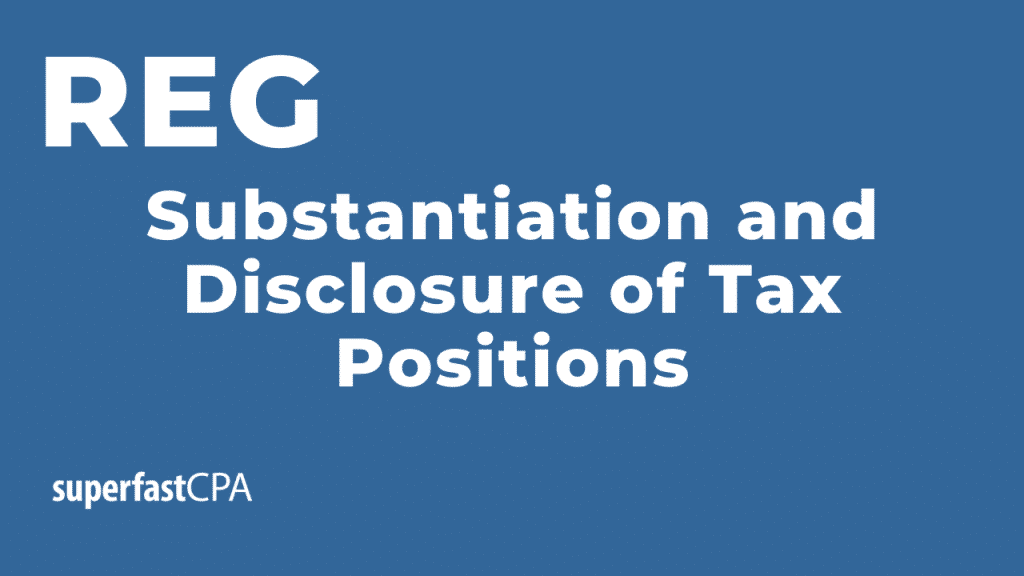This page provides a summary of key facts on substantiation and disclosure of tax positions on the CPA exam you’ll want to know.
Table of Contents
Substantiation and Disclosure of Tax Positions on the CPA Exam
According to Statements on Standards for Tax Services (SSTSs) #1, the CPA needs to comply with standards from taxing authorities if possible, on taking a specific tax position. A CPA/TRP that takes an “unreasonable position” can be punished.
Definition of a “Reasonable Position”
There are different levels of what a “reasonable position” means according to SSTS #1:
A “reasonable basis” would be if the CPA did their research and concluded there is a 20-33% chance the IRS would support the position. At this level, there needs to be a disclosure of the position so that the IRS can review it.
A “realistic possibility” of a position being upheld would be 33% or more.
Tax Positions Need “Substantial Authority”
However, Congress is the overriding authority and there is a provision that says it needs to be “substantial authority” to take a given tax position. In this case, “substantial” means at least a 40% chance that the IRS would accept the position. You don’t need to know how to judge the percentage, or how a “40% chance” would be calculated, but the standard is a 40% chance that the IRS would agree with the position.
So, the main thing to remember is that in general, there needs to be a 40% or more chance that the IRS would support a position in order to take any given federal tax position. If it’s not a federal tax issue, then the AICPA SSTS rule of greater than 33% would apply.
“Tax Shelter” Considerations
For a “tax shelter”, it is automatically unreasonable unless there is a “more likely than not” (more than 50%) chance that the IRS would accept the position.
The CPA needs to inform the client of potential penalties if the position is rejected, and if applicable, how penalties can be avoided through proper disclosure of the position.
What is “appropriate disclosure” for a tax position?
The information regarding the position needs to be “appropriately disclosed”, and this disclosure should include a description of the position being taken, the amount of tax involved, and the basis for the position. If the taxing authority has a specific form for such a position, then that form needs to be used. Or, if there are specific administrative guidance for a certain position, that needs to be followed as well.
Remember, a CPA doesn’t have to verify every number the client provides, but the CPA should make a “reasonable inquiry” if something doesn’t add up, or even just to clarify something with the client. If the client wants to pursue a tax position that the CPA doesn’t believe would be upheld, the CPA should decline to prepare or sign the return. If the client tells the CPA that documentation for a position exists, then the CPA can take the client at their word and does not need to take further action.
If it turns out that the client just lied to their CPA about a deduction, and is later figured out by the IRS, the CPA is not subject to any penalties.
Going along with this, the declaration that the CPA signs on a client’s return is warranting that the information provided by the client was relied upon in preparing the return unless it appeared incorrect or incomplete. This does not mean that every figure provided by the client was fully audited and substantiated by the CPA.
Other Items
Chang in Legislation Affecting Previous Tax Advice
If legislation causes a change to previous advice given to a client, the CPA is actually NOT required to notify the client of the changes, unless the exact issue was specifically the reason for the engagement.
Unanswered Questions on a Federal Tax Return
If a question on a federal return has not been answered, there needs to be “reasonable grounds” for not answering the question.
Errors Discovered on a Previous Tax Return
If errors are discovered on a previous return, the CPA’s duty is to inform the client of the errors and suggest an amended return, but the decision is up to the client.
Client Altering Figures on a Return
If, for example, a CPA does a client’s return, and then the client alters figures before sending in the return, and then the CPA finds out later, the CPA is NOT obligated take any action such as contacting the IRS, but the CPA should obviously evaluate their relationship with the client in respect to any further engagements.













